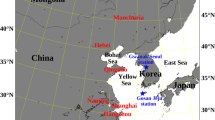Abstract
The climatology of dust storms in northern China and Mongolia (33°N–54°N, 73°E–136°E) is characterized at a 1-km resolution based on Moderate Resolution Imaging Spectroradiometer (MODIS) thermal observations during 2000–2010. The dust was extracted with the dynamic reference brightness temperature differences (DRBTD) dust detection algorithm. The major dust source regions are deserts, including the Tarim Basin, Hexi Corridor, Gobi in Mongolia and northern China, Horqin Sandy Land and Qaidam Basin. Dust storms occur most frequently in the Tarim Basin, with a maximum frequency (above 10%) in the eastern narrow inlet of the Taklimakan Desert around Lop Nor. Significant annual and seasonal variations are found for dust events. More than 63.8% of dust events occur in spring from March to May, with the maximum proportion (up to 29.6%) occurring in April. Severe dust storms occur mainly in the deserts in northern and northwestern China, and the largest source region is the eastern narrow inlet and the southern margin of the Taklimakan Desert.
Similar content being viewed by others
References
Atkinson J D, Murray B J, Woodhouse M T et al., 2013. The importance of feldspar for ice nucleation by mineral dust in mixed-phase clouds. Nature, 498: 355–358.
Herman J R, Bhartia P K, Torres O et al., 1997. Global distribution of UV-absorbing aerosols from Nimbus 7/TOMS data. Journal of Geophysical Research-Atmospheres, 102: 16911–16922.
Hsu N C, Tsay S C, King M D et al., 2006. Deep blue retrievals of Asian aerosol properties during ACE-Asia. IEEE Transactions on Geoscience and Remote Sensing, 44: 3180–3195.
Huang L, Jiang J H, Tackett J L et al., 2013. Seasonal and diurnal variations of aerosol extinction profile and type distribution from CALIPSO 5-year observations. Journal of Geophysical Research-Atmospheres, 118: 4572–4596.
Jickells T D, An Z S, Andersen K K et al., 2005. Global iron connections between desert dust, ocean biogeochemistry, and climate. Science, 308: 67–71.
Kurosaki Y, Mikami M, 2003. Recent frequent dust events and their relation to surface wind in East Asia. Geophysical Research Letters, 30(4). doi: 10.1029/2003gl017261.
Lai L W, Cheng W L, 2008. The impact of air quality on respiratory admissions during Asian dust storm periods. International Journal of Environmental Health Research, 18: 429–450.
Liu Y, Liu R G, Cheng X, 2013. Dust detection over desert surfaces with thermal infrared bands using dynamic reference brightness temperature differences. Journal of Geophysical Research-Atmospheres, 118: 8566–8584.
Luo Y X, Zheng X B, Zhao T L et al., 2014. A climatology of aerosol optical depth over China from recent 10 years of MODIS remote sensing data. International Journal of Climatology, 34: 863–870.
Mao R, Gong D Y, Bao J D et al., 2011. Possible influence of Arctic Oscillation on dust storm frequency in North China. Journal of Geographical Sciences, 21: 207–218.
Nobileau D, Antoine D, 2005. Detection of blue-absorbing aerosols using near infrared and visible (ocean color) remote sensing observations. Remote Sensing of Environment, 95: 368–387.
Prospero J M, Ginoux P, Torres O et al., 2002. Environmental characterization of global sources of atmospheric soil dust identified with the Nimbus 7 Total Ozone Mapping Spectrometer (TOMS) absorbing aerosol product. Reviews of Geophysics, 40: 1–31.
Rivas-Perea P, Rosiles J G, Cota-Ruiz J, 2013. Statistical and neural pattern recognition methods for dust aerosol detection. International Journal of Remote Sensing, 34: 7648–7670.
Shao Y, Dong C H, 2006. A review on East Asian dust storm climate, modelling and monitoring. Global and Planetary Change, 52: 1–22.
Tan M H, Li X B, Xin L J, 2014. Intensity of dust storms in China from 1980 to 2007: A new definition. Atmospheric Environment, 85: 215–222.
Uno I, Eguchi K, Yumimoto K et al., 2009. Asian dust transported one full circuit around the globe. Nature Geoscience, 2: 557–560.
Wald A E, Kaufman Y J, Tanre D et al., 1998. Daytime and nighttime detection of mineral dust over desert using infrared spectral contrast. Journal of Geophysical Research-Atmospheres, 103: 32307–32313.
Xiao F J, Zhou C P, Liao Y M, 2008. Dust storms evolution in Taklimakan Desert and its correlation with climatic parameters. Journal of Geographical Sciences, 18(4): 415–424.
Yang X H, He Q, Ali M et al., 2013. Near-surface sand-dust horizontal flux in Tazhong: The hinterland of the Taklimakan Desert. Journal of Arid Land, 5(2): 199–206.
Yu H, Kaufman Y J, Chin M et al., 2006. A review of measurement-based assessments of the aerosol direct radiative effect and forcing. Atmospheric Chemistry and Physics, 6: 613–666.
Zhao Y, Li H J, Huang A N et al., 2013. Relationship between thermal anomalies in Tibetan Plateau and summer dust storm frequency over Tarim Basin, China. Journal of Arid Land, 5(1): 25–31.
Zheng S, Cao C X, Singh R P, 2014. Comparison of ground based indices (API and AQI) with satellite based aerosol products. Science of the Total Environment, 488: 400–414.
Author information
Authors and Affiliations
Corresponding author
Additional information
Foundation: National Natural Science Foundation from China, No.41301354; No.41171285; Youth Science Funds of LREIS, CAS, No.08R8B6G0YA
Rights and permissions
About this article
Cite this article
Liu, Y., Liu, R. Climatology of dust storms in northern China and Mongolia: Results from MODIS observations during 2000–2010. J. Geogr. Sci. 25, 1298–1306 (2015). https://doi.org/10.1007/s11442-015-1235-2
Received:
Accepted:
Published:
Issue Date:
DOI: https://doi.org/10.1007/s11442-015-1235-2




